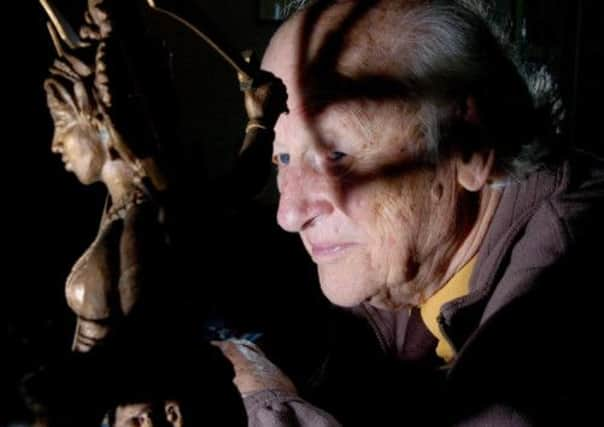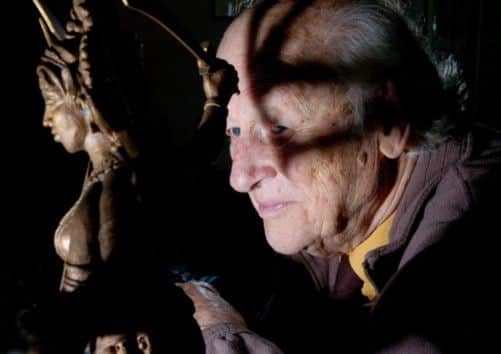Video: Animation giant who brought monsters to life


The celebrated special effects animator, who has died aged 92, perfected a technique of stop-motion animation which created memorable scenes in films such as Jason and the Argonauts and Clash of the Titans.
The American made his models by hand and then shot the action frame by frame to create sequences such as the seven skeletons which come alive in Jason and the Argonauts, a scene which took him three months to film.
Advertisement
Hide AdAdvertisement
Hide AdHis death in London was confirmed in a statement yesterday from the foundation he set up.


“Harryhausen’s genius was in being able to bring his models alive,” it added. “Whether they were prehistoric dinosaurs or mythological creatures, in Ray’s hands they were no longer puppets but became instead characters in their own right, just as important as the actors they played against and in most cases even more so.”
Harryhausen’s fascination with animated models began when he saw Willis O’Brien’s creations in King Kong in 1933. He made his first home-movies in 1935.
Over the next 46 years he made some of the best-known pictures to feature animation – Mighty Joe Young (1949), One Million Years BC (1966) and the three movies based on the adventures of Sinbad.
Advertisement
Hide AdAdvertisement
Hide AdOver the years tributes came from film-makers Peter Jackson, George Lucas, Steven Spielberg and James Cameron.
Cameron said: “I think all of us who are practitioners in the arts of science fiction and fantasy movies now all feel that we’re standing on the shoulders of a giant.”
British animator Nick Park said: “In my mind he will always be in the king of stop-motion animation.”
Yesterday tributes were paid by current and previous staff at Bradford’s National Media Museum which benefited from a donation of more than 20,000 objects from Harryhausen’s collection of artwork and models.
Advertisement
Hide AdAdvertisement
Hide AdPaul Goodman, head of collections projects, called him a “gentleman” and a “giant of animation”.
“His creativity, innovation and vision influenced many of the leading lights in film,” he added.
“Open any book on the history of cinema special effects and two names are always mentioned: Georges Méliès, the great French pioneer, and Ray Harryhausen, although Ray always preferred to be recognised for his contribution to ‘visual effects’. Whenever people talk about Ray’s work, they inevitably mention Dynamation, which broke new ground in animation.
“Dynamation was a truly revolutionary idea. It was an extension of previous efforts by Willis O’Brien to create interaction between humans and models.
Advertisement
Hide AdAdvertisement
Hide Ad“This had proven hugely labour-intensive and expensive – the latter factor being important where low budget films were under production. Ray sought to overcome this. Dynamation allowed the stop motion animation of ‘creatures’ – as Ray liked to call them – to be inserted directly into the action, therefore creating the illusion of interacting with actors. This concept may appear apparently straightforward but in reality, it was a technical tour-de-force. It proved enormously effective.
“In these days of big budget film production, the art and craft of the ‘one man band’ often remain uncelebrated and forgotten. This will never be the case with Ray. Often working alone, Ray developed an idea which was to revolutionise animation, and the opportunities for life-like human engagement.
“The Museum’s relationship with Ray has always been strong – the Museum was delighted to mount a retrospective of Ray’s work here several years ago and, since 2010, the Museum has worked in close partnership with the Ray & Diana Harryhausen Foundation, created to celebrate and safeguard his legacy, to catalogue and preserve Ray’s personal collection, which was pledged to the Museum on his 90th birthday.
“The Museum is proud to say that Ray (and his family and close associates) have been stalwart friends and supporters for many years. We salute and celebrate his legacy, his ingenuity and his vision – one which deserves to be secured for the benefit of future generations, so they too can understand just what a contribution he made.”
Advertisement
Hide AdAdvertisement
Hide AdYorkshire Post film critic Tony Earnshaw, who interviewed Harryhausen several times, described him as a perfectionist and a gentleman.
“What came across to me was that he retained a childlike wonder for the movies and for his craft. His fans – kids, fathers and grandfathers – were in awe of him.”